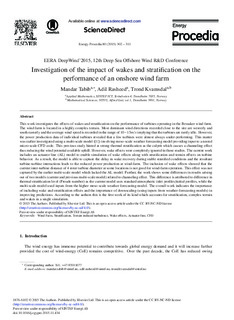Investigation of the impact of wakes and stratification on the performance of an onshore wind farm
Journal article, Peer reviewed
Published version

View/
Date
2015Metadata
Show full item recordCollections
- Publikasjoner fra CRIStin - SINTEF AS [5801]
- SINTEF Digital [2501]
Abstract
This work investigates the effects of wakes and stratification on the performance of turbines operating in the Bessaker wind farm. The wind farm is located in a highly complex terrain. Most dominant wind directions recorded close to the site are westerly and south easterly and the average wind speed is recorded in the range of 10–15m/s implying that the turbines are rarely idle. However, the power production data of individual turbines revealed that a few turbines were almost always under-performing. This matter was earlier investigated using a multi-scale model ( [1]) involving meso-scale weather forecasting model providing input to a nested micro-scale CFD code. This previous study hinted at strong thermal stratification as the culprit which causes a channeling effect thus reducing the wind potential available uphill. However, wake effects were completely ignored in those studies. The current work includes an actuator line (AL) model to enable simulation of wake effects along with stratification and terrain effects on turbine behavior. As a result, the model is able to capture the delay in wake recovery during stable stratified conditions and the resultant turbine-turbine interactions leads to the reduced power production at wind-farm. The inclusion of wake effects showed that the current inter-turbine distance of 4 rotor turbine diameter at some locations is not good for wind-farm operation. This effect was not captured by the earlier multi-scale model which lacked the AL model. Further, the work shows some differences in results arising out of two models (current and previous multi-scale model) related to channeling effect. This difference is attributed to difference in thermal stratification level (Froude number) as the current model uses standard atmospheric inlet profiles/initial profiles, while the multi-scale model used inputs from the higher meso-scale weather forecasting model. The overall work indicates the importance of including wake and stratification effects and the importance of downscaling (using inputs from weather-forecasting models) in improving predictions. According to the authors this is the first work of its kind which accounts for stratification, complex terrain and wakes in a single simulation.
